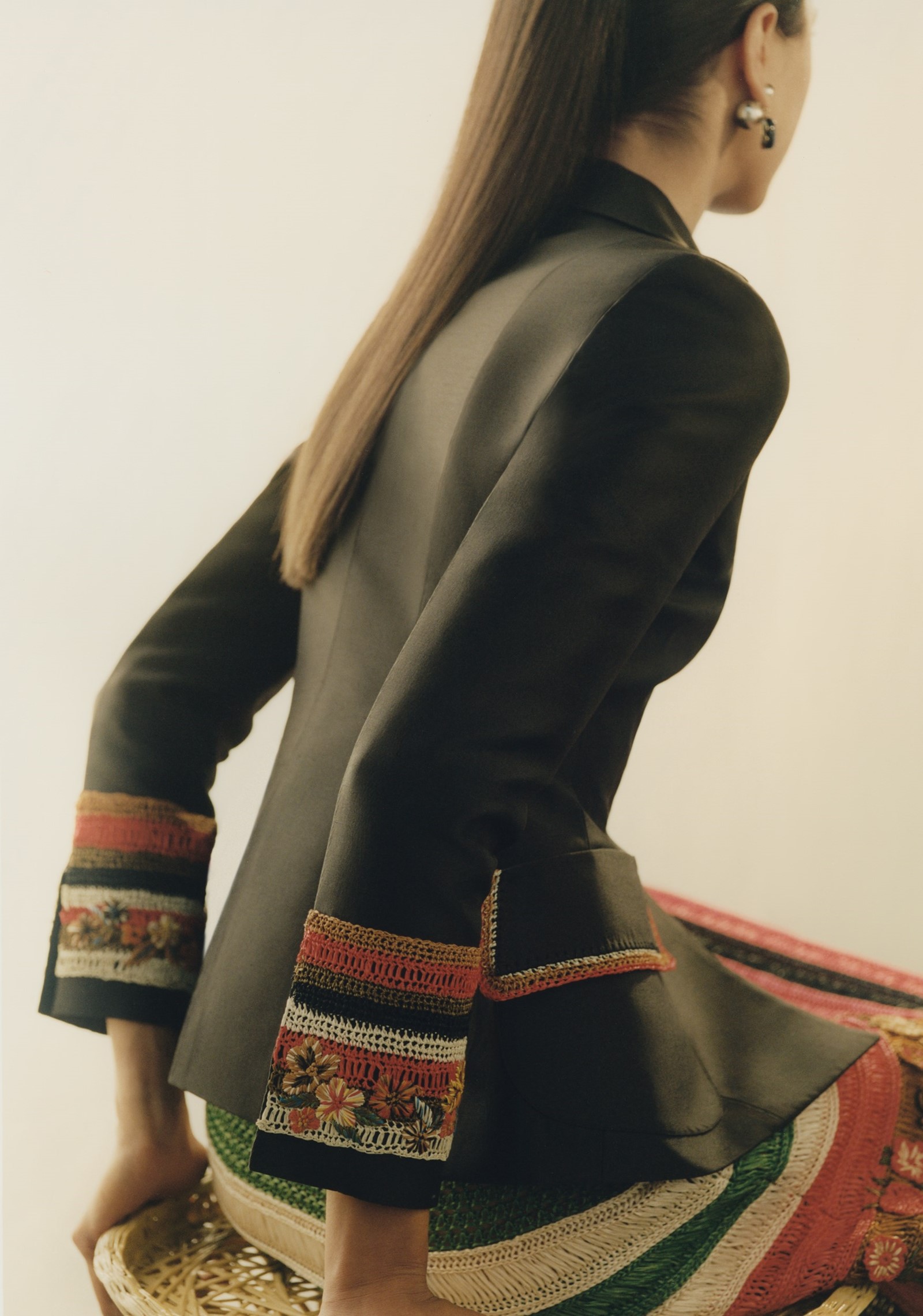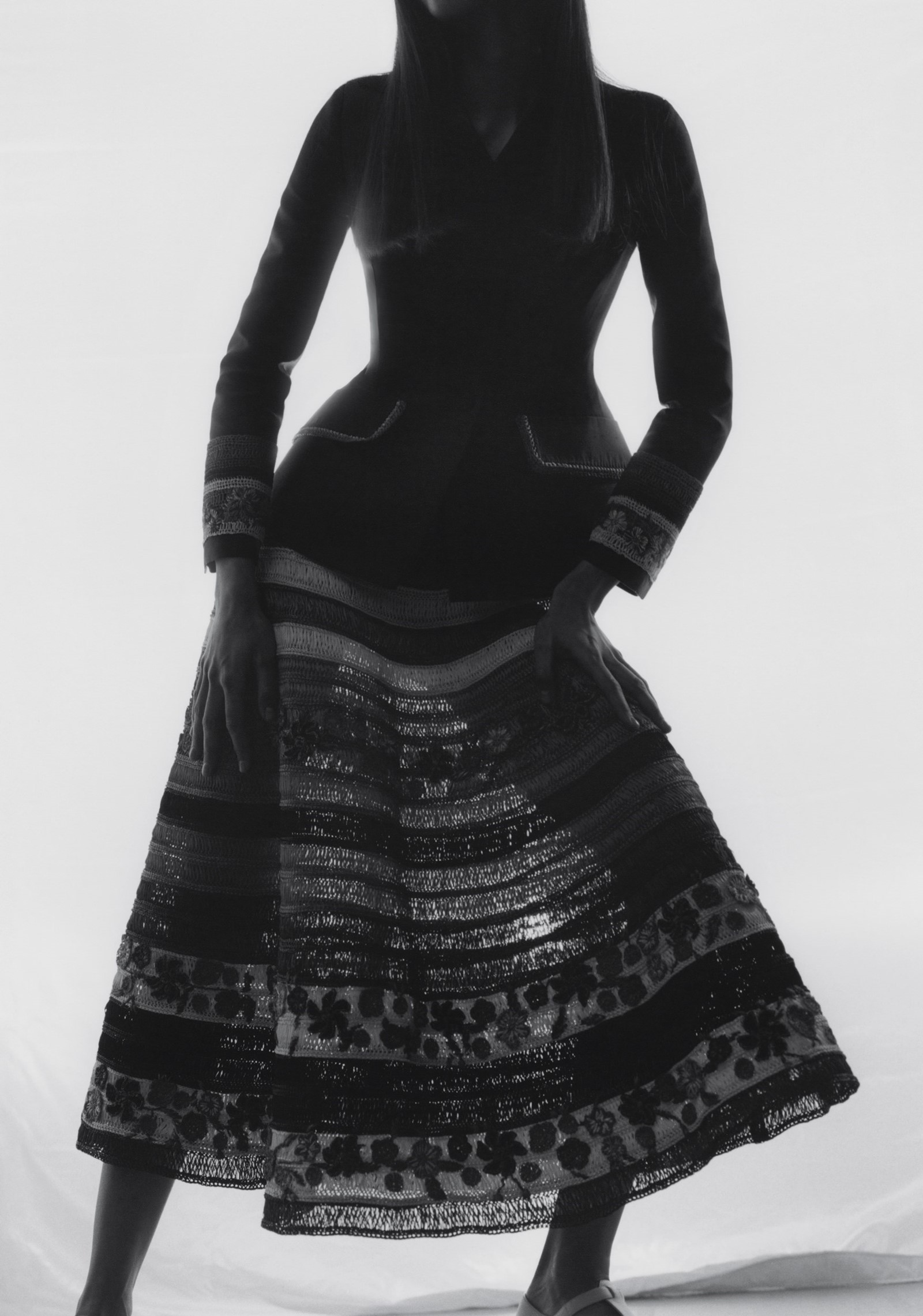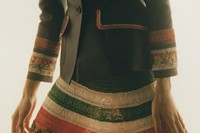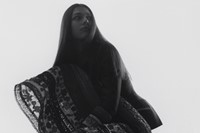One night last April, guests gathered in the candle-lit ruins of Marrakech’s El Badi Palace for Dior’s Cruise 2020 show. A country famously beloved by Yves Saint Laurent, the first designer to take up Christian Dior’s mantle after his death in 1957, Morocco has long represented a geographical crossroads. For Maria Grazia Chiuri, the maison’s current artistic director of womenswear, it was the perfect setting for a collection seeking to act as a site of cultural exchange between the European house and African traditions. To this end, she involved a team of global collaborators including London-based designer Grace Wales Bonner, who designed her own iteration of Dior’s hourglass-waisted Bar jacket. True to her repute for masterful tailoring and intricate craft, the Wales Bonner Bar hugged the waist and flared at the hip, seemingly seamless in compact black wool, with pockets and sleeves edged in vibrantly coloured hand-crocheted raffia embroidered with a dancing border of tiny posies, and was worn over a full skirt in the same weightless and unconventional textile. That night marked the first time that Dior had invited another fashion designer to reimagine its most iconic look.
First, the necessary history. The tailleur Bar, a cocktail suit in silk tussore and black wool, rumoured to have been named after the Bar Hemingway of the Ritz Paris, appeared as part of Christian Dior’s debut collection, staged on February 12, 1947, in the dove-grey salons of his newly founded couture house at 30 Avenue Montaigne, Paris. The collection was the fashion revolution later dubbed the New Look, a proposal of glamorous, exquisite femininity, embodied best by the rounded shoulders, nipped-in waist and padded hips that formed the silhouette of the Bar jacket, worn over a lavish, calf-length pleated skirt.
After years of austerity and drab uniformity, it was a radical image. The war may have been over, but rationing remained, and even the Mona Lisa – long since spirited out of Paris in a crate – was yet to return to view in the still-shuttered Louvre. The city, in other words, may not have been ready for it, but with the triumphant swish of an extravagantly heavy hem, modernity had arrived.
Back to the present. It was a visit to A Time for New Dreams, the exhibition that Wales Bonner – who won the 2016 LVMH Prize – devised at London’s Serpentine Galleries in early 2019 that inspired Chiuri to contact her and discuss a collaboration. “I think it crossed over with a lot of things that Maria was exploring in the collection – but also more generally in terms of the mysticism and spirituality,” the designer explained from her London studio last December, seated in front of stacked bookshelves.
The show’s works – including flower installations by Kapwani Kiwanga, a Bible by David Hammons, and a sculpture comprising photographs, feathers, stones and other objects by Liz Johnson Artur – all brought to mind ideas of ritual and belief. It’s an appropriate connection for Chiuri to have made: Monsieur Dior was famously a deeply superstitious man – consulting psychics and collecting talismans throughout his life. Since arriving at the maison for Spring/Summer 2017, Chiuri has channelled this quality in her work, incorporating astrology, tarot cards, and some of Dior’s favourite symbols, such as the bee, heart and star.
Another lucky charm was lily of the valley, one of Dior’s favourite flowers, which he often wore in his buttonhole and even had stitched into the hems of dresses before shows. He paid great attention to such hidden details, lining the insides of skirts in silk so that the interfacings that gave structure did not damage women’s stockings. This sensitivity towards his wearers stood out in particular to Wales Bonner, who is primarily a menswear designer, as she embarked on her journey within the house – starting with a “magical” visit to the archives. “The garments that I saw have a really amazing emotional quality – I was really drawn to and seduced by that,” she recalled. “[There is a] love towards women and an embrace of women – even in the construction.”
“For me as a designer, I’m trying to create something that’s a hybrid – that celebrates European luxury and beauty but also introduces another cultural perspective and allows that to sit in relation to it with the same kind of weight and integrity” – Grace Wales Bonner
Such care was no less apparent in the Bar jacket, a silhouette that can, due to its proportions, appear unyielding. “I was really interested in how the shape was created and how tailoring elements were incorporated in quite a soft way,” she said, noting its “precision and beauty and simplicity” and ability to feel contemporary, even today. Both that softness and sense of modernity have been central to Chiuri’s work – as the house’s first female artistic director, she has brought Dior’s depiction of women as femmes fleurs down to earth somewhat, often pairing her more-relaxed, elastic Bar jackets with T-shirts and flat shoes.
Wales Bonner’s singular vision – inspired by her British and Jamaican heritage, and a penchant for meticulous research – is one that unites traditions of European fashion with narratives and histories usually excluded from it. “For me as a designer, I’m trying to create something that’s a hybrid – that celebrates European luxury and beauty but also introduces another cultural perspective and allows that to sit in relation to it with the same kind of weight and integrity,” she explained. “So it was very interesting for me, coming from that perspective, to be able to collaborate with a brand like Dior and introduce other cultural narratives in line with how I work. It’s also important for me to be part of the conversation with these brands as well. It’s not about being an outsider to those experiences, those opportunities – it’s about being part of the conversation.”
For this project in particular, she looked at archive photography of 1940s and 1950s Afro-Cuban tailoring – a source of inspiration for a past collection. “That was where I could see Dior silhouettes resonating in a world that was more familiar to me.” Wales Bonner’s resulting design references the past yet feels contemporary, incorporates traditional techniques, and speaks to the crosscultural dialogues fostered by Chiuri.


“It was really about emphasising the waist and also bringing in the handwork of the raffia embroidery, which has kind of Caribbean and Rastafarian colours. I was working with that craft while having something more of Dior’s heritage – so there were also flowers done in those tones as well.” As an independent designer, working with the storied house’s skilled petites mains was eye-opening. “I think the really incredible thing about working with Dior was just access to the resources and the amazing atelier and being able to develop things I wouldn’t necessarily have access to,” she surmised.
Of course, with the show’s location and African influence, such collaboration is vital to getting on the right side of the fine line between appreciation and appropriation. “I think trying to represent something from a singular perspective is always going to be problematic,” Wales Bonner said. “It’s always important to have a multiplicity of voices and perspectives.” Those voices were present through a multitude of collaborations, including a piece by designer Pathé’O, who made Nelson Mandela’s shirts; African wax prints created in collaboration with Ivory Coast artisans Uniwax, facilitated by anthropologist Anne Grosfilley; and a partnership with African-American painter Mickalene Thomas, who applied her own work to the Bar silhouette.
To Wales Bonner, the collaboration was natural, the intentions pure. “I feel like [Chiuri’s] point was also very sensitive and personal and inspired by the same level of rigour and research into fabrication and craft. To open up conversations is a very brave thing for a designer at a luxury house to do.”
The best way to describe it may well be with a founding principle of the house itself: ‘new’.
Hair: Yumi Nakada-Dingle at Home Agency using Bumble and Bumble. Make-up: Bea Sweet at Jaq Management using Backstage and Capture Totale Collections By Dior. Model: Nikoline Mekjan at Next. Manicure: Jessica Thompson. Photographic assistants: Stefan Ebelewicz and Adam Richardson. Make-up assistant: Gareth Harris. Post-production: Dave at Phoenix Bespoke. Special thanks to Georgina Pragnell at Accoutrement.
This story originally featured in AnOther Magazine Spring/Summer 2020, which is on sale internationally now.






